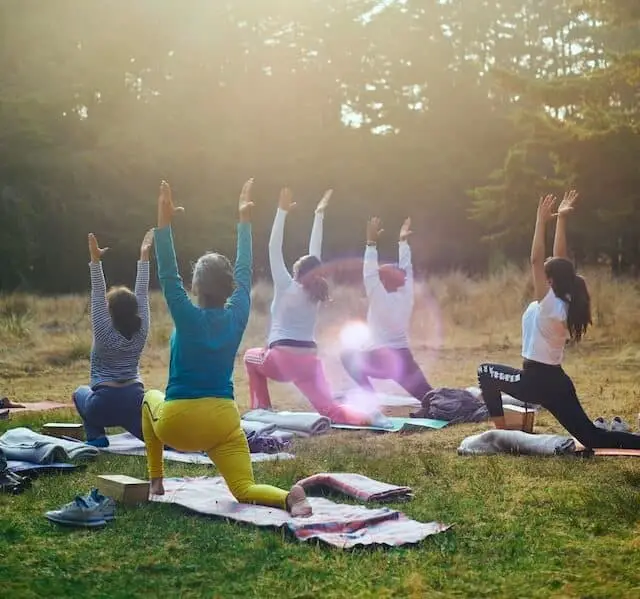Yoga and Feldenkrais are two different practices with some key similarities.
They both have the intention of helping people improve their physical and mental wellbeing, but they approach this goal in different ways.
If you’re considering adding yoga or Feldenkrais to your regular routine, it’s important to know the differences between the two approaches.
In this blog post, I’ll help you understand the key distinctions between yoga and Feldenkrais so you can decide which is the best practice for you!
Contents
Stats and Info
- Feldenkrais is a form of body awareness education, whereas yoga is a physical practice with a spiritual basis
- Feldenkrais emphasizes the cognitive process of learning how to move, while Yoga emphasizes the physical process of training the body
- Feldenkrais focuses on efficient movements and improved posture, while Yoga focuses on flexibility, balance, and developing muscle strength
- Feldenkrais practitioners tend to be older, while Yoga is popular among all ages
- Feldenkrais relies on gentle, slow movements, while Yoga relies on faster and more intense movements
- Feldenkrais can be done both in a class setting or in private sessions, while Yoga is typically done in a class setting
Some comparisons:
- Feldenkrais: body awareness education
- Yoga: physical practice with spiritual basis
- Feldenkrais: cognitive process of learning
- Yoga: physical process of training the body
- Feldenkrais: efficient movements & improved posture
- Yoga: flexibility, balance & developing muscle strength
- Feldenkrais: older practitioners
- Yoga: popular among all ages
- Feldenkrais: gentle, slow movements
- Yoga: faster and more intense movements
- Feldenkrais: class setting or private session
- Yoga: class setting
Related – Exploring life through some of the most impactful Moshe Feldenkrais’ quotes!
The Feldenkrais Method has long been seen as an alternative to Yoga, but the two practices are actually quite different.
Many people experience pain points and pet peeves when it comes to Yoga, such as the focus on perfect poses, the repetition of flows, and the lack of individualized instruction for each student.
Feldenkrais, on the other hand, focuses on developing connections between the mind and body, and allowing the individual to identify and understand patterns of movement.
As a result, Feldenkrais is a gentler form of exercise, with the focus being on alignment and relaxation rather than pushing the body.
Another potential fix to Yoga-related pain points and pet peeves is an activity such as Tai Chi, which also focuses on individualized instruction and relaxation.
In addition, there are also a range of breathing exercises, such as pranayama and meditation, which can be used to help settle and calm the mind.
Finally, one can look for Yoga teachers who focus on adapting poses to the individual student, rather than trying to make them perfect a certain pose.
Yoga vs Feldenkrais
Most people think yoga and Feldenkrais are indistinguishable, however, they are two distinct modalities with their own merits.
While Feldenkrais utilizes many postures and movements similar to yoga, it is more than just a physical practice.
It is a form of somatic education aimed at understanding how our brain and body coordinate, using the power of awareness to help us make subtle yet powerful shifts on an internal level.
Feldenkrais aims to develop an awareness of the body’s natural pathways and postures. In contrast, yoga encourages people to follow set patterns of postures and breathing.
Feldenkrais methods provide the opportunity for each individual to find the most comfortable and efficient posture for themselves.
With Feldenkrais, you can develop an awareness of how your body can move and move better.
The Feldenkrais approach to movement examines how we use ourselves from the inside out.
It is based on principles of functional anatomy and principles of human learning. It is practical and experiential.
Whereas yoga may employ meditation and visualization exercises, Feldenkrais does not use them.
Instead, it relies on gentle movement and guided awareness in order to promote self-discovery of our own resources and capacities.
Exploring the Difference Between Feldenkrais and Yoga
For those looking to explore alternative methods of exercise, Feldenkrais and Yoga are two popular choices.
Although both practices offer various physical and mental benefits, there are distinct differences between the two.
Firstly, Feldenkrais is much less physically demanding than Yoga.
It focuses on using gentle movements and using a light touch to improve coordination, flexibility, and posture.
In contrast, Yoga is a much more physically demanding form of exercise, with poses such as stretches and inversions requiring a greater level of strength, agility, and balance.
Additionally, Feldenkrais focuses on the connection between the mind and body and encourages practitioners to become more aware of their movements, whereas Yoga is more about the physical practice itself.
It is clear, then, that while Feldenkrais and Yoga share similarities, they are ultimately two distinct practices with different effects.
Feldenkrais and yoga are both forms of movement that have healing properties. However, these forms of movement have different applications and benefits.
In yoga, poses are used to increase flexibility and encourage a sense of calm.
Feldenkrais emphasizes the importance of awareness, body-mind integration and efficient movement patterns.
Unlike yoga, there are no poses or postures in Feldenkrais and instead, we use gentle, non-habitual movements to help create new patterns and connect to the body in a healthier way.
This type of movement emphasizes a more holistic approach, focusing on how the body, mind, and breath work together to create healthy movement patterns.
The goal is to help people unlearn existing movement patterns that are painful and inefficient and replace them with new, more efficient ones.
Feldenkrais Exercises and Improved Wellbeing
The Feldenkrais Method® is an innovative approach to mind-body movement and exercise that involves connecting physical movements with mental awareness.
This type of movement helps to create a powerful balance between physical and mental health, having the potential to dramatically improve posture, flexibility, coordination, and mindfulness.
Feldenkrais can be thought of as a type of yoga without the postures, as it emphasizes the internal awareness of the body.
Through this awareness, the goal is to improve fluidity of movement and decrease tension, reducing pain and allowing the body to move more smoothly and easily.
Unlike yoga, which is focused primarily on the physical and requires specific postures, the Feldenkrais Method® focuses on the inner sensations of the mind-body connection and encourages exploration of movement and comfort.
As a result, it may be possible to experience greater levels of physical, mental, and emotional wellbeing.
The unique methodology of the Feldenkrais Method sets it apart from Yoga.
Unlike Yoga, Feldenkrais focuses more on self-discovery, rather than following a set of postures and poses.
Through the practice of Feldenkrais, you can gain an improved understanding of how your body moves, and how to make more intentional, mindful movements.
Additionally, Feldenkrais puts emphasis on breathing and relaxation, which helps you to further develop your body awareness and mindfulness.
It is a more gentle approach to physical activity and requires more exploration of your body, encouraging you to be creative and open to new experiences.
Related – Here is the Feldenkrais Method and exercises explained in detail.
Conclusion: A Holistic Approach to Wellness
The Feldenkrais Method is an effective tool for achieving increased wellness, physical and mental.
Through the Feldenkrais Method, practitioners can access greater ease in movement, improved posture, and a better understanding of their own body and its capabilities.
On the other hand, yoga is an ancient practice which brings together physical, mental and spiritual benefits.
While both practices share many common goals, they differ in philosophy, approach and goals.
I have personally experienced the effects of both Feldenkrais and yoga in my own life.
By combining the two practices, I have gained a better insight into my body and its capabilities, as well as increased flexibility and strength.
Each form of exercise has its own set of advantages and it is important to find what works best for you.
As we continue to explore ways of improving our physical and mental wellbeing, it is important to remember that a holistic approach incorporating both Feldenkrais and yoga is often the most effective.
While both practices offer unique benefits of their own, the combination of the two can lead to improved balance, greater wellbeing, and an enhanced sense of connectedness.
FAQ
How is Feldenkrais different from Yoga?
Feldenkrais is a form of physical and psychological therapy that uses gentle movements and non-invasive techniques to retrain the brain and reduce pain.
Unlike yoga, Feldenkrais focuses on the quality of movement rather than the physical exercise.
Can I use Feldenkrais to help with my posture?
Yes, the Feldenkrais Method can be used to improve posture, coordination, and range of motion. It can also be used to help manage chronic pain and tension.
What are the benefits of the Feldenkrais Method?
The Feldenkrais Method has many benefits, including improved coordination, better posture, increased range of motion, improved balance, and reduction of pain and tension.
How long does a Feldenkrais session last?
Feldenkrais sessions typically last anywhere from 45 minutes to 2 hours.
Is the Feldenkrais Method safe?
Yes, the Feldenkrais Method is a safe and non-invasive form of therapy. It is suitable for people of all ages, and there are no known side effects.
Image credits – Photo by Amauri Mejía on Unsplash

I’m a MA, (CMT) Certified Massage Therapist, Licensed Massage Therapist (LMT), and Reiki Master — I’m a licensed massage therapist with over 10 years of experience in the industry.

